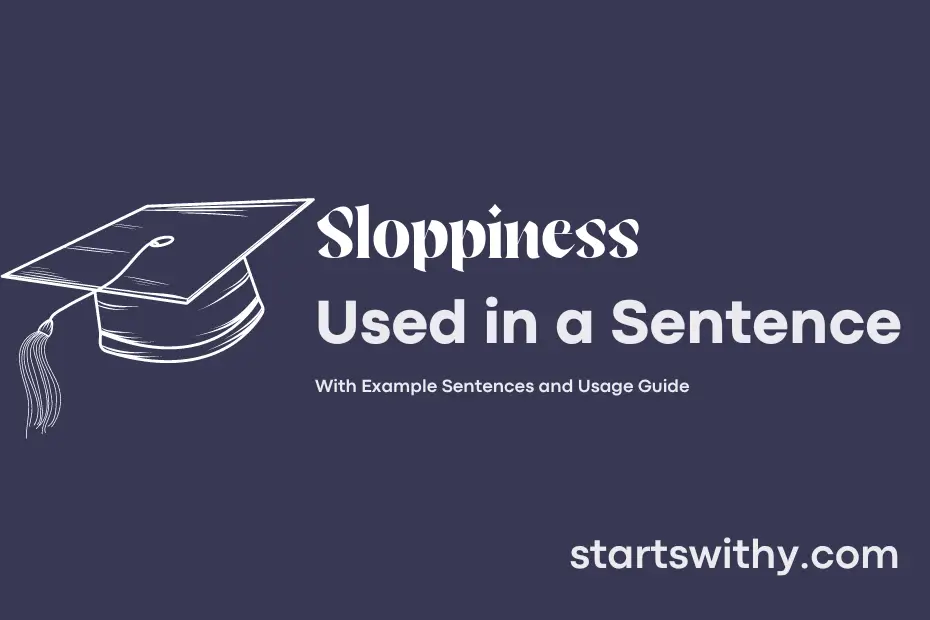Do you know what sloppiness in writing looks like? Sloppiness refers to the careless or untidy manner in which something is done, often resulting in errors or lack of precision. This can manifest in various forms, such as grammatical mistakes, spelling errors, or unclear communication.
When sloppiness creeps into writing, it can weaken the message being conveyed and create confusion for the reader. It is important to pay attention to detail and strive for clarity in order to avoid sloppiness in your writing.
7 Examples Of Sloppiness Used In a Sentence For Kids
- Sloppiness can make our work look messy.
- Let’s try to avoid sloppiness when drawing our pictures.
- We should always write neatly and avoid sloppiness.
- Eating with sloppiness can make a big mess.
- Let’s clean up our toys to avoid sloppiness.
- We should tie our shoelaces properly to avoid sloppiness.
- Practicing good handwriting can help us avoid sloppiness in our work.
14 Sentences with Sloppiness Examples
- Sloppiness in formatting can lead to lost marks in your final research paper.
- Make sure to double-check your calculations to avoid any sloppiness in your accounting assignment.
- Group presentations require coordination and preparation to avoid any sloppiness in delivery.
- Always proofread your essays to eliminate any sloppiness in grammar and spelling.
- Organize your study materials to prevent any sloppiness in your exam preparation.
- Time management is crucial to avoid sloppiness in meeting assignment deadlines.
- Lack of attention to detail can result in sloppiness in your project presentation.
- Prepare a detailed outline to prevent any sloppiness in your term paper.
- Clear communication is essential to avoid sloppiness in group projects.
- Keeping track of your references can prevent any sloppiness in your bibliography.
- Prioritize your tasks to prevent sloppiness in balancing academics and extracurricular activities.
- Stay organized to avoid sloppiness in your study schedule.
- Ask for feedback from your peers to catch any sloppiness in your research work.
- Utilize study groups to help in minimizing sloppiness in understanding complex topics.
How To Use Sloppiness in Sentences?
Sloppiness is the quality of being careless or untidy. When using this word in a sentence, it is important to consider the context in which it is being used.
Here are some tips on how to correctly use the word sloppiness in a sentence:
-
Identify the situation: Sloppiness can refer to a person’s appearance, work, behavior, or even the way something is done. Consider what aspect of carelessness or untidiness you are trying to convey in your sentence.
-
Choose the right words: When constructing your sentence, make sure to use descriptive language that conveys the idea of sloppiness clearly. Words like “untidy”, “disorganized”, “haphazard”, and “negligent” can help emphasize the meaning.
-
Provide context: If necessary, give additional information in the sentence to clarify what you mean by sloppiness. This will help the reader better understand the message you are trying to convey.
-
Check for clarity: Before finalizing your sentence, read it over to ensure that the use of sloppiness makes sense and conveys the intended meaning. Consider if there are any other words that could better capture the idea of carelessness or untidiness.
By following these guidelines, you can effectively incorporate the word sloppiness into your writing to convey the concept of being careless or untidy.
Conclusion
In conclusion, the quality of writing can be significantly affected by sloppiness, leading to confusion and a lack of clarity for the reader. When sentences are crafted with sloppiness, they can be riddled with errors, making the message difficult to understand and diminishing the overall effectiveness of communication. Additionally, sloppiness in sentences can reflect poorly on the writer’s professionalism and attention to detail.
To avoid these pitfalls, writers should strive for precision, coherence, and accuracy in their sentences. By taking the time to carefully construct each sentence with attention to detail and avoiding sloppiness in wording, grammar, and structure, writers can convey their message more effectively and ensure a clear and concise communication with their audience.



